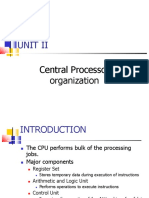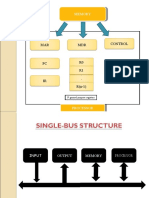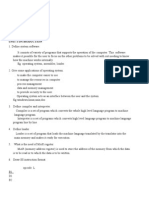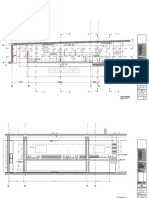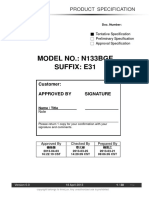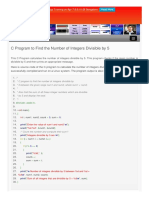Memory Locations and Addresses
Memory Locations and Addresses
Uploaded by
rosev15Copyright:
Available Formats
Memory Locations and Addresses
Memory Locations and Addresses
Uploaded by
rosev15Original Description:
Original Title
Copyright
Available Formats
Share this document
Did you find this document useful?
Is this content inappropriate?
Copyright:
Available Formats
Memory Locations and Addresses
Memory Locations and Addresses
Uploaded by
rosev15Copyright:
Available Formats
Memory Locations and
Addresses
Memory consists of many millions of
storage elements
One storage element can store one bit
of information
Memory is organized so that a group of
n bits (referred as word ) can be stored
or retrieved
.
.
.
.
.
.
n
bits
b30 b0 b1 b31
Sign bit: b31 = 0 for positive numbers
b31 = 1 for negative numbers
8 bits 8 bits 8 bits 8 bits
ASCII
Character
ASCII
Character
ASCII
Character
ASCII
Character
(a) A signed integer
(b) Four characters
.
.
.
.
.
.
0
1
2^k - 1
k no. of address
bits
24 address bits
generates an
address space of
2^24 (16 M)
locations
2^10 1K (1 Kilo =
1024)
2^20 1M (1 Mega)
2^30 1G (1 Giga)
2^40 1T (1 Tera)
Byte Addressability
a byte is 8 bits
the word length typically ranges from
16 to 64 bits
successive addresses refer to
successive byte locations in the
memory (generally used in computers)
Byte locations have addresses
0,1,2,.....
If the word length is 32 bits, successive
words are located at addresses
0,4,8,...... with each word consisting of
four bytes.
0 1 2 3
4 5 6 7
3 2 1 0
7 6 5 4
2^k-
4
2^k-
3
2^k-
2
2^k-
1
2^k-
1
2^k-
2
2^k-
3
2^k-
4
.
.
.
.
.
.
2^k-4
0
4
0
4
2^k-4
Word
Addres
s
Byte Address Byte Address
(a) Little-endian assignment (b) Big-endian assignment
Instructions and Instruction
Sequencing
A computer must have instructions to
perform four types of operations:
Data transfers between the the memory and the
processor registers
Arithmetic and Logical operations on data
Program sequencing and control
I/O transfers
Two notations of instructions
Register transfer notation
Assembly language notation
Register Transfer Notation
R1 [LOC]
The contents of memory location LOC are transferred
into processor register R1
R3 [R1] + [R2]
PLACE [R2]
Assembly Language Notation
Move LOC, R1
Add R1,R2,R3
Move R2, PLACE
Basic Instruction Types
C = A+B -------- HLL statement
C [A] + [B] -------- RTN
assuming this is done in single machine
instruction
Add A,B,C ---------ALN
general instruction of this type has the format
(three address instruction)
Operation Source1, Source2, Destination
Basic Instruction Types
Use of a sequence of simpler instructions (two
address instructions)
Add A,B
Move B, C
in RTN
B [A]+[B]
C [B]
general instruction of this type has the format
Operation Source, Destination
Some machine instructions specify only
one operand.
When the second operand is needed, it
is understood implicitly to be in a
unique location, generally accumulator
(a processor register) is used
they become one address instructions
Add LOC
Load PLACE
Store PLACE
Basic Instruction Types
C= A+B
Load A
Add B
Store C
Basic Instruction Types
Use of processor registers allows faster
accessing and results in shorter
instructions
Load A, Ri or Move A, Ri
Store Ri, LOC or Move Ri,LOC
and
Add LOC, Ri
Basic Instruction Types
C= A+B
Move A,Ri
Add B, Ri
Store Ri, C
Basic Instruction Types
Move A,Ri
Move B,Rj
Add Ri,Rj
Store Rj, C
Transfers that involve the memory are much slower
than transfers within the processor.
A substantial increase in speed is achieved when
processor registers are utilized effectively.
C = A+B -------- HLL statement
C [A] + [B] -------- RTN
Assumptions we make
Compiler allows one memory operand per instruction
Word length is 32 bits and the memory is byte addressable
Single word instruction can include a full memory address
The three instructions are in successive word locations,
starting at location i
Instruction Execution and Straight-Line
Sequencing
Move A,R0
Add B,R0
Move R0,C
.
.
.
.
.
.
.
.
.
Contents Address
i
i+4
i+8
A
B
C
Begin execution
here
3-Instruction
program
segment
Data for the
program
A program for C =[A]+[B]
Execution of the program
To begin execution of the program, the address
of its first instruction (i in this case) is placed into
the PC.
Processor fetches and executes the first
instruction using the information available in PC.
During the execution first instruction, PC is
incremented by 4 to point next instruction.
Instructions are executed one at a time in the
order of increasing addresses. This is called
Straight-Line Sequencing
Execution of the program
Executing an instruction is a two-phase procedure
First Phase Instruction Fetch
Instruction is fetched from the memory location whose address
is in the PC
And placed in Instruction Register (IR)
Second Phase Instruction Execute
Instruction is decoded to determine the operations to be
performed.
The specified operations are performed by the processor. This
involves
Fetching operands from memory or from processor registers
Arithmetic and logical operations
Storing results into memory or registers
At some point during this two-phase procedure, the PC
is incremented to point the next instruction to be
exexcuted
Move NUM1,R0
Add NUM2,R0
Add NUM3,R0
Add NUMn,R0
Move R0,SUM
.
.
.
.
.
.
.
.
.
i+4
i+8
i
i+4n-4
i+4n
SUM
NUM2
NUMn
NUM1
Branching
The program sequence is changed form
straight-line sequencing by a branching
instruction
Previous example can be done using LOOP
Loop is repeated as many times as the numbers
to be added
To check whether all numbers added a counter
variable is used and it is imitated with the count
of numbers to be added
Each time the loop executed next number is
added and the count is decremented by 1.
The loop is repeated until the count becomes 0.
to do this a conditional branch instruction is used
Move N,R1
Clear R0
Determine address
of Next number
and add Next
number to R0
Decrement R1
Branch>0 LOOP
Move R0,SUM
.
.
.
n
.
.
.
LOOP
Program
Loop
SUM
N
NUM1
NUM2
NUMn
Condition Codes
Processor keeps track of the
information about the results of
operations for use by subsequent
conditional branch instruction.
Those information bits are called
condition code flags and they are
saved as a group in a register called
condition code register or status
register.
Individual condition code flags are set
to 1 or cleared to 0 depending on the
outcome of the operation
Four commonly used flags are
N (Negative) -Set to 1 if the result is
negative; otherwise cleared to 0
Z (Zero) -Set to 1 if the result is 0;
otherwise cleared to 0
V (Overflow) - Set to 1 if arithmetic
overflow occurs; otherwise cleared to 0
C (Carry) - Set to 1 if a carry results
from the operation; otherwise cleared to 0
Addressing Modes
Addressing means the way to specify
the address of an operand.
The different ways (flexible) of
addressing are called addressing
modes.
The details differ from one computer
to other, but the concepts are the
same.
Name
Assembler Syntax Addressing Function
Immediate #value Operand=value
Register Ri EA=Ri
Absolute(Direct) LOC EA=LOC
Indirect (Ri)
(LOC)
EA=[Ri]
EA=[LOC]
Index X(Ri) EA=[Ri]+X
Base with index (Ri,Rj) EA=[Ri]+[Rj]
Base with index
and offset
X(Ri,Rj) EA=[Ri]+[Rj]+X
Relative X(PC) EA=[PC]+X
Auto increment (Ri)+ EA=[Ri];
Increment Ri;
Auto decrement -(Ri) Decrement Ri;
EA=[Ri]
EA=Effective address Value= a signed number
Variables and Constants
They are simplest data types
In assembly language, a variable is
represented by allocating a register or a
memory location to hold its value
Constants are represented in the
instruction itself
Immediate addressing
The operand is given explicitly in the
instruction
Constants are represented using
Immediate addressing
For example,
Move #200,R0
Add #6, R1
Register Addressing
The operand is the content of a
processor register; the
name(address) of the register is
specified in the instruction
For example,
Add R1,R0
Absolute Addressing (Direct
Addressing)
The operand is in a memory location;
the address of this location is given
explicitly in the instruction
For example,
Move LOC,PLACE
In the following example,
Move LOC,R1
Both register and absolute addressing
mode are used.
Example: A = B+6 --- C statement
In assembly language
Move B, R0
Add #6,R0
Move R0,A
Indirect Addressing
The instruction does not give the operand or its
address explicitly
Information about the memory address of the
operand is given in the instruction
This address is called effective address (EA) of
the operand
Effective address of the operand is the content of
register or memory location whose address is
given in the instruction
EA=[Ri]
EA=[LOC]
For Example,
Add (A), R0
Move (R1),R2
Add (R1),R0
.
.
.
Operand
B
Add (A),R0
.
.
.
B
.
.
.
Operand
Main
memor
y
Register
B
R1
A
B
(b) Through a memory location (a) Through a general-purpose
register
Address Contents
Move N,R1
Move #NUM1,R2
Clear R0
Add (R2),R0
Add #4,R2
Decrement R1
Branch>0 LOOP
Move R0,SUM
Initialization
LOOP
Use of indirect addressing in the program
discussed before
n
.
.
.
SUM
N
NUM1
NUM2
NUMn
Data in memory
The register or the memory location that
contains the address of operand is called
pointer
Indirect Addressing through registers are
used extensively.
But Indirect Addressing through memory
location is seldom used, because it
involves accessing memory twice to get
an operand
Index Addressing
It is useful in dealing with lists and arrays
The Effective Address of the operand is
generated by adding a constant value to the
contents of register
For example,
Add X(Ri), Rj
The EA of first operand is [Ri]+X
Add 20(R1),R2
Operand
.
.
.
1000
.
.
.
Add 1000(R1),R2
Operand
.
.
.
20
.
.
.
1000
1020
1000
1020
20=Offset
R1
R1
(a) Offset is given as a constant
(b) Offset is in the index register
INDEXED
ADDRESSING
20=Offset
n
Student ID
Test 1
Test 2
Test3
Student ID
Test 1
Test 2
Test3
.
.
.
N
LIST
LIST + 4
LIST + 8
LIST + 16
LIST + 12
Student 1
Student 2
A LIST OF STUDENTS MARKS.
Move #LIST,R0
Clear R1
Clear R2
Clear R3
Move N,R4
Add 4(R0),R1
Add 8(R0),R2
Add 12(R0),R3
Add #16,R0
Decrement R4
Branch>0 LOOP
Move R1,SUM1
Move R2,SUM2
Move R3,SUM3
LOOP
INDEXED ADDRESSING USED IN ACCESSING TEST SCORES
IN THE LIST IN THE PREVIOUS FIGURE
Relative Addressing
The Effective Address is determined by the Index
mode using the Program Counter in place of the
general purpose register
For Example,
Branch>0 -16(PC)
Auto increment Addressing
The Effective Address of the operand is the
contents of a register specified in the instruction.
After accessing the operand, the contents of this
register are automatically incremented to point
the next item in the list
For Example,
Add (R1)+, R0
Address Contents
Move N,R1
Move #NUM1,R2
Clear R0
Add (R2)+, R0
Decrement R1
Branch>0 LOOP
Move R0,SUM
Initialization
LOOP
n
.
.
.
SUM
N
NUM1
NUM2
NUMn
Data in memory
Auto decrement Addressing
The contents of a register specified in the
instruction are first automatically decremented
and are then used as the effective address of the
operand
For Example,
Add -(R1), R0
You might also like
- Common Defects in Gas CuttingDocument14 pagesCommon Defects in Gas CuttingASHVIN YADAVNo ratings yet
- CPUDocument50 pagesCPUabhishek sNo ratings yet
- Sample Fall Protection PlanDocument30 pagesSample Fall Protection PlanSoner Kulte100% (1)
- MemoryDocument43 pagesMemoryuma_saiNo ratings yet
- Unit-Iii: Instructions & Instruction SequencingDocument8 pagesUnit-Iii: Instructions & Instruction SequencingSANTOSH4176No ratings yet
- COA Mod2Document51 pagesCOA Mod2Boban MathewsNo ratings yet
- Instructions and Instruction SequencingDocument25 pagesInstructions and Instruction Sequencingsamueljamespeter100% (4)
- CSE 243: Introduction To Computer Architecture and Hardware/Software InterfaceDocument31 pagesCSE 243: Introduction To Computer Architecture and Hardware/Software Interfaceachaparala4499No ratings yet
- MSB LSB: Unit Ii: Machine Instructions and ProgramsDocument17 pagesMSB LSB: Unit Ii: Machine Instructions and ProgramsNaveen A Rao RaoNo ratings yet
- L 5-AddressingModesDocument44 pagesL 5-AddressingModesLekshmiNo ratings yet
- CSA Unit 4Document71 pagesCSA Unit 4amrutapatil7483No ratings yet
- Code GenerationDocument25 pagesCode GenerationlyeabsraNo ratings yet
- Ch2 Lec2 Instruction Sets CharacteristicsDocument46 pagesCh2 Lec2 Instruction Sets CharacteristicsAlazar DInberuNo ratings yet
- Ch2 - Lec2 - Instruction Sets CharacteristicsDocument48 pagesCh2 - Lec2 - Instruction Sets CharacteristicsMagarsaa Qana'iiNo ratings yet
- Addressing Modes Instruction Set ArchitectureDocument15 pagesAddressing Modes Instruction Set ArchitectureSandeep VermaNo ratings yet
- CSE 243: Introduction To Computer Architecture and Hardware/Software InterfaceDocument26 pagesCSE 243: Introduction To Computer Architecture and Hardware/Software Interfaceachaparala4499No ratings yet
- Unit-2 Machine Instructions and Programs (Contd... ) and Basic Processing UnitDocument21 pagesUnit-2 Machine Instructions and Programs (Contd... ) and Basic Processing Unitprathuasharao2017No ratings yet
- CSE 243: Introduction To Computer Architecture and Hardware/Software InterfaceDocument31 pagesCSE 243: Introduction To Computer Architecture and Hardware/Software Interface123456ranoNo ratings yet
- Solved Problems 1Document4 pagesSolved Problems 1kimoNo ratings yet
- CD Unit 5 RVDocument23 pagesCD Unit 5 RVAkashNo ratings yet
- SS-2 MarksDocument47 pagesSS-2 MarkssivayagNo ratings yet
- Ss 1Document78 pagesSs 1lovelykdkingNo ratings yet
- CTCD Unit 4Document25 pagesCTCD Unit 4Ranjit47 HNo ratings yet
- cs2304 System Software 2 Marks and 16 Marks With AnswerDocument18 pagescs2304 System Software 2 Marks and 16 Marks With Answermanojkumar024No ratings yet
- CSE 259 Lecture3Document11 pagesCSE 259 Lecture3robin haqueNo ratings yet
- CAO - Mod1 Mymry, Adress, Adressing ModesDocument47 pagesCAO - Mod1 Mymry, Adress, Adressing ModesvkvNo ratings yet
- Computer OrganisationDocument27 pagesComputer OrganisationAmandeep SharmaNo ratings yet
- Assemblyunit 1Document51 pagesAssemblyunit 1RubyNo ratings yet
- Instruction Formats & Addressing Modes Prof. M P Patel: Topic: Guided byDocument21 pagesInstruction Formats & Addressing Modes Prof. M P Patel: Topic: Guided byHarshit BhayaniNo ratings yet
- System Software 2 Marks and 16 Marks With AnswerDocument23 pagesSystem Software 2 Marks and 16 Marks With AnswerpriyaaramNo ratings yet
- Coa Unit III Part IIDocument23 pagesCoa Unit III Part IIkontham sirisejaNo ratings yet
- System Software2markDocument31 pagesSystem Software2markMohammed HashimNo ratings yet
- Instructions and Instruction SequencingDocument12 pagesInstructions and Instruction SequencingComputer NotesNo ratings yet
- Addressing ModesDocument9 pagesAddressing ModesSouvik MondalNo ratings yet
- (SS) System Software Viva Question and AnswersDocument15 pages(SS) System Software Viva Question and AnswersVenkatesh NaiduNo ratings yet
- 2 MarksDocument17 pages2 MarksGeetha ParthibanNo ratings yet
- CSE 30321 - Lecture 02-03 - in Class Example Handout: Discussion - Overview of Stored ProgramsDocument8 pagesCSE 30321 - Lecture 02-03 - in Class Example Handout: Discussion - Overview of Stored ProgramsSandipChowdhuryNo ratings yet
- DpcoDocument19 pagesDpcos.brainyajayNo ratings yet
- Instructions and Instruction SequencingDocument12 pagesInstructions and Instruction SequencingComputer NotesNo ratings yet
- Chapter 3 LMSDocument37 pagesChapter 3 LMSvexadid644No ratings yet
- Instruction Execution and Straight-Line SequencingDocument5 pagesInstruction Execution and Straight-Line SequencingRavindra RathodNo ratings yet
- Annauniv 5thsem Sytsemsoftware Students CornersDocument21 pagesAnnauniv 5thsem Sytsemsoftware Students CornersstudentscornersNo ratings yet
- Rajalakshmi Engineering College: CS2308 - SS Lab VVQ Unit I-IntroductionDocument17 pagesRajalakshmi Engineering College: CS2308 - SS Lab VVQ Unit I-IntroductionssarvinthNo ratings yet
- Central Processing UnitDocument11 pagesCentral Processing UnitPace InfotechNo ratings yet
- Chapter 8 - Code GenerationDocument22 pagesChapter 8 - Code Generationsindhura2258No ratings yet
- Cs8491 CA QbankDocument128 pagesCs8491 CA QbankSuresh Kanna100% (1)
- General Register OrganizationDocument16 pagesGeneral Register OrganizationGovind UpadhyayNo ratings yet
- 8051 Instruction SetDocument73 pages8051 Instruction SettbijleNo ratings yet
- Code GenerationDocument22 pagesCode GenerationDivyanshu KantolNo ratings yet
- Code GenerationDocument49 pagesCode GenerationCandy AngelNo ratings yet
- Instruction Set Architecture: Logic and Computer Design FundamentalsDocument50 pagesInstruction Set Architecture: Logic and Computer Design FundamentalslogintojalluriNo ratings yet
- Module-6 COMPUTER ARCHITECTUREDocument25 pagesModule-6 COMPUTER ARCHITECTUREpranaykumarghosh41No ratings yet
- 8051 Assembly LanguageDocument39 pages8051 Assembly LanguagemanvithbNo ratings yet
- MODULE-2 - Addressing ModesDocument104 pagesMODULE-2 - Addressing ModestasmiyashaikhNo ratings yet
- C Ompiler Theory: (Intermediate C Ode Generation - Abstract S Yntax + 3 Address C Ode)Document32 pagesC Ompiler Theory: (Intermediate C Ode Generation - Abstract S Yntax + 3 Address C Ode)Saipavanesh GuggilapuNo ratings yet
- Coa Unit1Document99 pagesCoa Unit1Ashish SharmaNo ratings yet
- Ca Lec4Document20 pagesCa Lec4Sana IftikharNo ratings yet
- Addressing ModesDocument20 pagesAddressing ModesAkhil B SkariaNo ratings yet
- Conceptual Programming: Conceptual Programming: Learn Programming the old way!From EverandConceptual Programming: Conceptual Programming: Learn Programming the old way!No ratings yet
- Introduction to Computer Organization: An Under the Hood Look at Hardware and x86-64 AssemblyFrom EverandIntroduction to Computer Organization: An Under the Hood Look at Hardware and x86-64 AssemblyNo ratings yet
- Social IntelligenceDocument1 pageSocial Intelligencerosev15No ratings yet
- Early Cultivation: Neolithic Asia Minor Ancient Greece Levant Mesopotamian Fertile CrescentDocument1 pageEarly Cultivation: Neolithic Asia Minor Ancient Greece Levant Mesopotamian Fertile Crescentrosev15No ratings yet
- OliveDocument1 pageOliverosev15No ratings yet
- CreativityDocument1 pageCreativityrosev15No ratings yet
- Knowledge Representation Commonsense KnowledgeDocument1 pageKnowledge Representation Commonsense Knowledgerosev15No ratings yet
- Planning: Automated Planning and SchedulingDocument1 pagePlanning: Automated Planning and Schedulingrosev15No ratings yet
- Machine Perception Tactile Sensors Computer Vision Speech Recognition Facial Recognition Object RecognitionDocument1 pageMachine Perception Tactile Sensors Computer Vision Speech Recognition Facial Recognition Object Recognitionrosev15No ratings yet
- LongDocument1 pageLongrosev15No ratings yet
- The Breadth of Commonsense KnowledgeDocument1 pageThe Breadth of Commonsense Knowledgerosev15No ratings yet
- Artificial Intelligence (AI) IsDocument1 pageArtificial Intelligence (AI) Isrosev15No ratings yet
- LearningDocument1 pageLearningrosev15No ratings yet
- LTE Advanced 3Gpp: See Also: BelowDocument1 pageLTE Advanced 3Gpp: See Also: Belowrosev15No ratings yet
- Uncertain Probability Economics Combinatorial Explosion: Reasoning, Problem SolvingDocument1 pageUncertain Probability Economics Combinatorial Explosion: Reasoning, Problem Solvingrosev15No ratings yet
- Modes of Operation: Landline Channels Full-Duplex Bandwidth ImtsDocument1 pageModes of Operation: Landline Channels Full-Duplex Bandwidth Imtsrosev15No ratings yet
- IMT-2000 Compliant 4G StandardsDocument1 pageIMT-2000 Compliant 4G Standardsrosev15No ratings yet
- Background: System Spectral Efficiency BitDocument1 pageBackground: System Spectral Efficiency Bitrosev15No ratings yet
- IMT-Advanced Requirements: Itu-R Cellular SystemDocument1 pageIMT-Advanced Requirements: Itu-R Cellular Systemrosev15No ratings yet
- 4G Is The Fourth Generation ofDocument1 page4G Is The Fourth Generation ofrosev15No ratings yet
- Technical Understanding: International Telecommunications Union-Radio Communications SectorDocument1 pageTechnical Understanding: International Telecommunications Union-Radio Communications Sectorrosev15No ratings yet
- T-Mobile International AG Is A German: Telekom)Document1 pageT-Mobile International AG Is A German: Telekom)rosev15No ratings yet
- Derived Unit Electric Potential Electric Potential Difference Electromotive Force Alessandro Volta Voltaic Pile BatteryDocument1 pageDerived Unit Electric Potential Electric Potential Difference Electromotive Force Alessandro Volta Voltaic Pile Batteryrosev15No ratings yet
- Radiotelephone (Or Radiophone) Is A: Communications Radio Audio Radiotelegraphy Telegraph Video Two-Way RadioDocument1 pageRadiotelephone (Or Radiophone) Is A: Communications Radio Audio Radiotelegraphy Telegraph Video Two-Way Radiorosev15No ratings yet
- Voltage, Electric Potential Difference, Electric Pressure or Electric Tension (FormallyDocument1 pageVoltage, Electric Potential Difference, Electric Pressure or Electric Tension (Formallyrosev15No ratings yet
- Cryptography or Cryptology (From: - LogiaDocument1 pageCryptography or Cryptology (From: - Logiarosev15No ratings yet
- UsesDocument1 pageUsesrosev15No ratings yet
- Software Hotspots: WAN Internet Bridging Tethering Android Apple OS X Windows Mobile Linux Atheros Broadcom Intel NicsDocument1 pageSoftware Hotspots: WAN Internet Bridging Tethering Android Apple OS X Windows Mobile Linux Atheros Broadcom Intel Nicsrosev15No ratings yet
- Supplementary Slides For Software Engineering: A Practitioner's Approach, 5/eDocument9 pagesSupplementary Slides For Software Engineering: A Practitioner's Approach, 5/erosev15No ratings yet
- Supplementary Slides For Software Engineering: A Practitioner's Approach, 5/eDocument13 pagesSupplementary Slides For Software Engineering: A Practitioner's Approach, 5/erosev15No ratings yet
- Piton Policarbonato Chorro-Niebla 1.5 Giacomini A7bp Certf. Ul-FmDocument2 pagesPiton Policarbonato Chorro-Niebla 1.5 Giacomini A7bp Certf. Ul-FmEdgar YauriNo ratings yet
- Furniture DetailDocument40 pagesFurniture DetailEdi CahyadiNo ratings yet
- Information Handout3012013Document6 pagesInformation Handout3012013Nikhil MeshramNo ratings yet
- Tutorium Refrigeration SolutionDocument20 pagesTutorium Refrigeration SolutionwanpudinNo ratings yet
- BMW E39 Radio Obc Mid ManualDocument65 pagesBMW E39 Radio Obc Mid ManualNLBananasNo ratings yet
- Pega Ba Flow and Data Modeling: AshockDocument19 pagesPega Ba Flow and Data Modeling: AshockvenkatNo ratings yet
- Naming Convention For Android DevelopmentDocument5 pagesNaming Convention For Android DevelopmentnylhstarNo ratings yet
- 109-23-24 Ambattur QuestionsDocument1 page109-23-24 Ambattur Questionsjohnstruct archNo ratings yet
- Hvac-Mappysil CR 404 - Acoustic InsulationDocument1 pageHvac-Mappysil CR 404 - Acoustic Insulationanwar2masNo ratings yet
- Zhong Chen Slides 1620847925786Document8 pagesZhong Chen Slides 1620847925786Priya ReddyNo ratings yet
- Magnets and Electromagnets (Requires JAVA)Document5 pagesMagnets and Electromagnets (Requires JAVA)Izza Zamora NeriaNo ratings yet
- Model No.: N133Bge Suffix: E31: Product SpecificationDocument38 pagesModel No.: N133Bge Suffix: E31: Product SpecificationkornolNo ratings yet
- F3826CDocument14 pagesF3826CJumongNo ratings yet
- MIS StructureDocument39 pagesMIS StructureAbdullah GubbiNo ratings yet
- ASME 36 (Ss Piping)Document1 pageASME 36 (Ss Piping)Muhammad AhsanNo ratings yet
- Jetstream Europe Brochure EnglishDocument6 pagesJetstream Europe Brochure EnglishFernando ZamoraNo ratings yet
- Cara Menghitung Ukuran Pipa Kapiler RefrigerasiDocument54 pagesCara Menghitung Ukuran Pipa Kapiler RefrigerasiZikko FirmansyahNo ratings yet
- L.6. Pemodelan MatematisDocument23 pagesL.6. Pemodelan MatematisNasikhuddin100% (1)
- Sennheiser Price List 2010Document12 pagesSennheiser Price List 2010Karen IlustrisimoNo ratings yet
- Mos Field Effect Transistor: Data SheetDocument8 pagesMos Field Effect Transistor: Data SheetAdam SchwemleinNo ratings yet
- Mediabox: User'S ManualDocument42 pagesMediabox: User'S ManualMohd Khairul Md DinNo ratings yet
- Interface para Usar El Osciloscopio Como Diagnosticador Por ImágenesDocument5 pagesInterface para Usar El Osciloscopio Como Diagnosticador Por ImágenesWilliams BurgosNo ratings yet
- Acematt Ok 412Document1 pageAcematt Ok 412optimus_1404No ratings yet
- Be Happy and Make Others To Be Happy - Oracle EBS R12 Purchasing, Inventory, Order Management QueriesDocument17 pagesBe Happy and Make Others To Be Happy - Oracle EBS R12 Purchasing, Inventory, Order Management QueriesGanapathiraju SravaniNo ratings yet
- WWW Sanfoundry Com C Program Number Divisible by 5Document5 pagesWWW Sanfoundry Com C Program Number Divisible by 5प्रतीक प्रकाशNo ratings yet
- SpinchillercontrollerDocument59 pagesSpinchillercontrollerIgnacio LopezNo ratings yet
- MESC Description PI04Document4 pagesMESC Description PI04Reastu SaputraNo ratings yet
- PFMEA New FormatDocument63 pagesPFMEA New FormatArshad AnsariNo ratings yet


